Overview
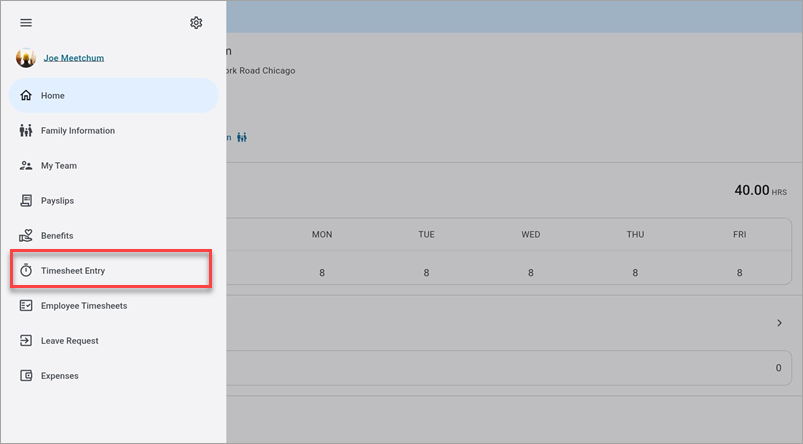
The Personal Timesheet menu option launches the Timesheet Entry screen, where users can enter, save, and submit timesheets. It allows users to efficiently log time for various activities related to jobs, equipment, work orders, and overhead, and manage their time entries, tasks, and employee time records with ease.
Timesheet Entry

Timesheet Entry screen
Upon launching the Timesheet Entry screen, the system will automatically display the employee associated with the logged-in access code.
Users can enter time for themselves or for any employees they are responsible for. If a user has no access to other employees, they can only enter their own time.
Employee Timesheets
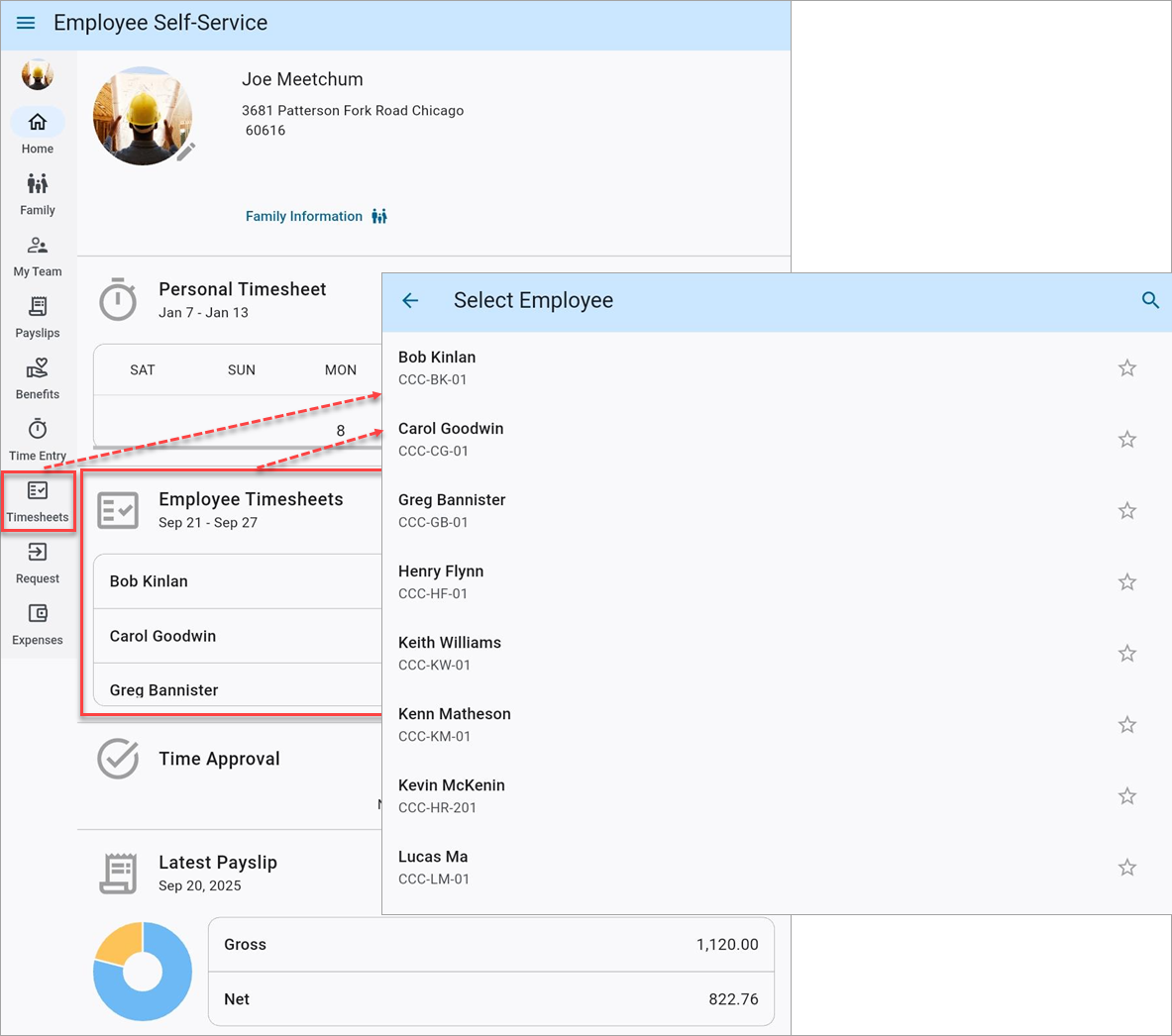
Pop-up window launched from the Employee Timesheets field
Employee timesheets can be accessed from the Home screen under Employee Timesheets, or from the Timesheets menu icon (![]() ), as shown in the screenshot above.
), as shown in the screenshot above.
The Employee Timesheets field's List of Values (LOV) displays only the employees that the user has access to. If no other employees are linked to the user under the Employee and Pay Run tabs of the Access Codes Administration screen in the E-Time module, the LOV will only show the employee attached to the logged-in access code. This also includes the employees where the access code has access as an approver. Refer to E-Time - Access Codes Administration for more information.
Notes
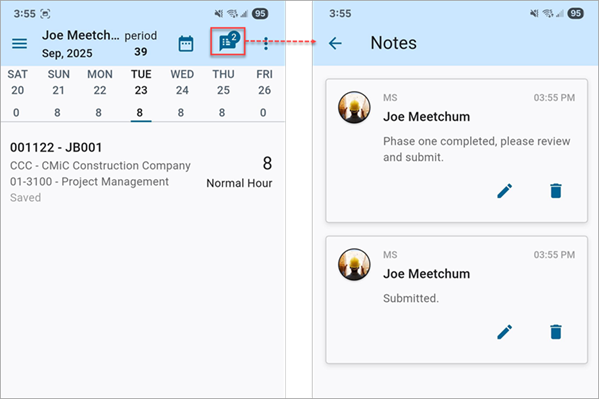
The Notes icon is used to view, add, reply, edit, and delete personal or work-related notes. Employees can edit and delete their own notes at any time and also view and reply to notes from their managers. Notes are automatically updated and accessible on both Construct ESS mobile and web upon logging in. The Notes icon will display a number badge indicating the number of notes entered for the individual employee.
Managers can view notes written by employees via the ESS Administrator - Timesheet Approval (Web) screen.
Pay Period
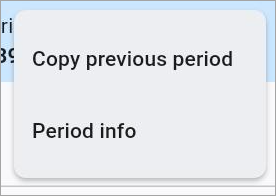
Copy Previous Period
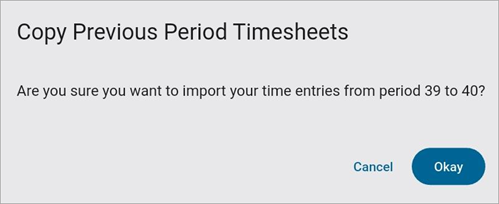
This option is used to copy time entries from the previous week to the current period.
Period Info
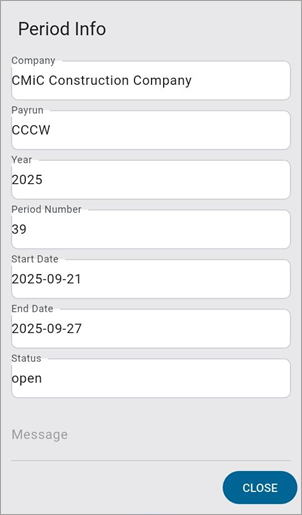
If "Period Info" is selected, the system will display the current open period from the company pay period setup, as defined in the Pay Periods screen in the US Payroll module. If not defined, the period where the current date falls will be shown.
[Submit] – Button
![Screenshot of Timesheet Entry with [Submit] button highlighted.](../../Resources/Images/ESS_App_R12/ConstructESS_TimeEntry14_v1.2.9.png)
Clicking the [Submit] button launches a pop-up window used
Entering Time
Click on the Add icon (![]() ) to insert a timesheet entry.
) to insert a timesheet entry.
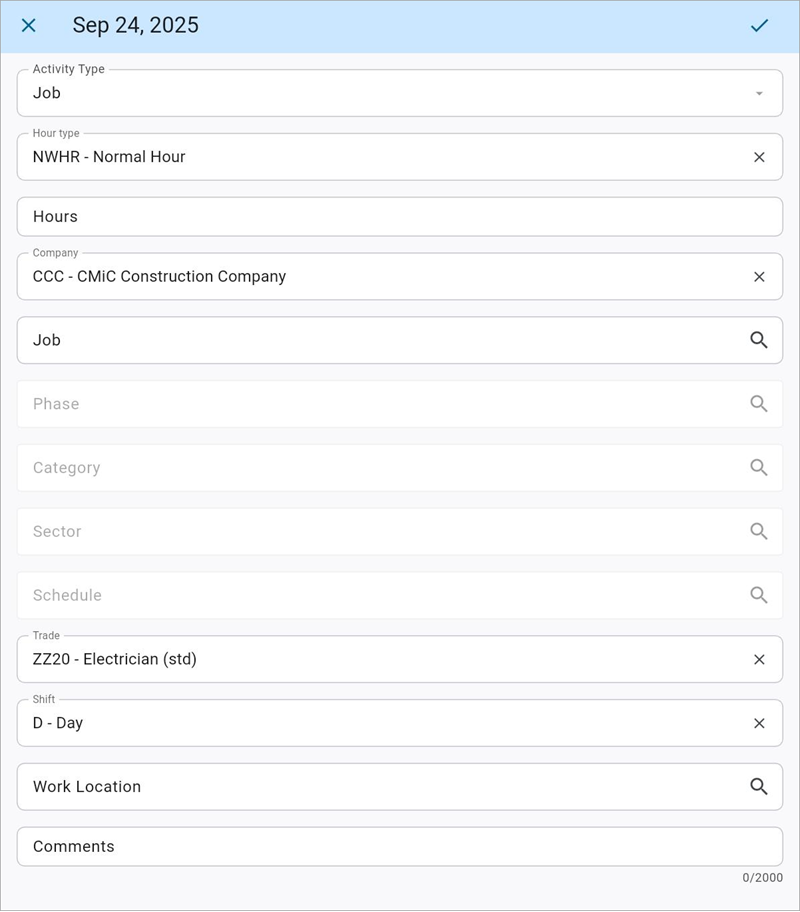
In the Activity Type field, select the desired activity type from the drop-down menu. Options available include "Job", "Overhead", "Equipment", or "Work Order".
NOTE: Users must have security permissions set in the E-Time Role Maintenance screen in the E-Time module to apply time against these activities. These permissions include the following checkboxes: Allow E-Timesheet for Job, Allow E-Timesheet for Overhead, Allow E-Timesheet for Equipment, and Allow E-Timesheet for Work Order. Refer to E-Time - Role Maintenance (E-Time Roles) for more information. To learn more about the "Equipment" and "Work Order" options, refer to Entering Time Against Equipment and Work Orders.
Select an hour type from the Hour Type field and then enter the number of hours in the Hours field.
NOTE: If using the In/Out Time Entry feature, upon selecting a specific hour type which has been flagged to validate in/out times, the interface will dynamically alter, replacing the standard Hours field with distinct fields for Time In and Time Out. Refer to In/Out Time Entry for more information on using this feature.
Depending on the activity type selected, complete the remaining task details. The fields available depend on the selected activity type. Enter any comments in the Comments field.
NOTE: Users must have security permissions set in the E-Time Role Maintenance screen in the E-Time module to access the
When finished, press the Save icon (![]() ).
).
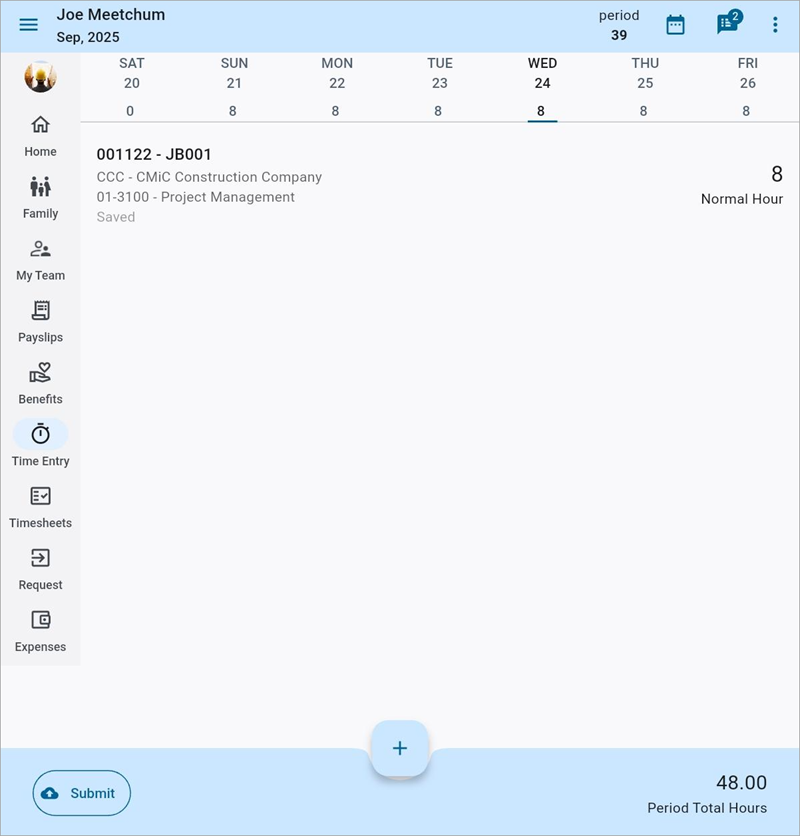
After inputting the data and saving, the time entry will be recorded against the timesheet and the details will be available on the Timesheet Entry screen.
In/Out Time Entry
Employees can enter timesheets by entering their daily in and out times if the setup described in this section is completed. When entering time, a clock interface will appear, allowing the employee to select the appropriate time in and time out for their work hours. The system will automatically calculate the total hours worked based on the entered in/out times.
Setup for In/Out Time Entry
Access to entering in/out times in employee timesheets is controlled at the system level, and then granted to users based on settings at the employee profile level. Access can also be controlled at the HR level using the Employee Dashboard screen, and this setting ultimately takes precedence over the system and profile levels. After access has been granted, the types of hours that are available for in/out time entry can also be defined. The settings, which are located across several screens, are described in more detail below.
System Options

Pgm: SYSOPT – System Options; standard Treeview path: System > Setup > System Options – E-TimeSheet tab
The In/Out Time Entry feature is used to control whether in-out times are used during timesheet entry. It must be enabled at the system level to allow employees to enter in-out times in the Timesheet Entry screen. This feature is enabled using the Require In-Out Time in E-Timesheet field located on the E-Time Sheet tab of the System Options screen in the System Data module. From the field's drop-down menu, selecting an FLSA type of “Exempt”, “Non-Exempt”, or “Both” will give employees with that FLSA type assigned on their Employee Profile record, access to the Time In and Time Out fields in the Timesheet Entry screen. If this field is set to “Not Applicable”, the In/Out option will not be available to employees when entering timesheets.
Employee Profile
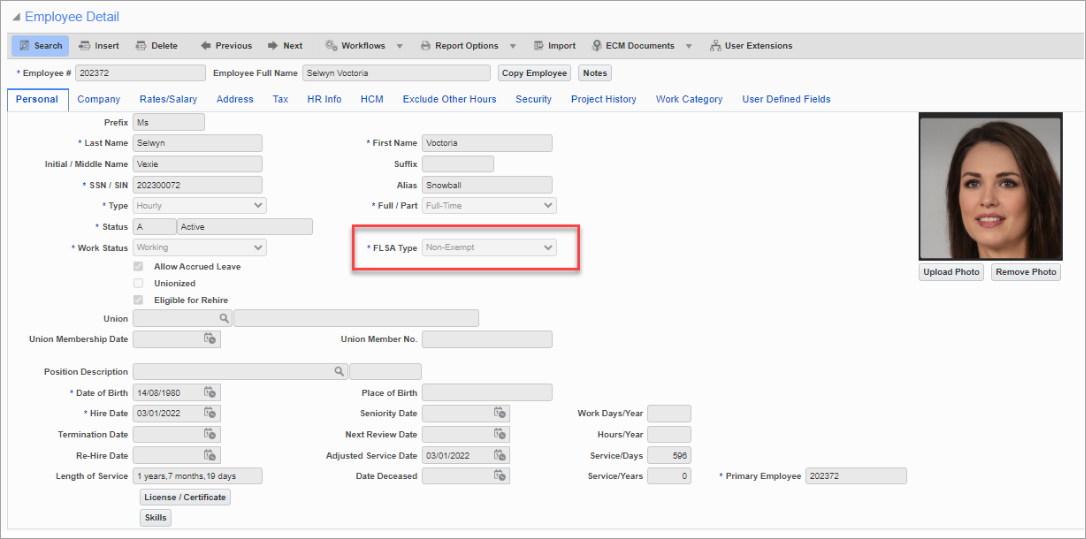
Pgm: PYEMPLOY – Employee Profile; standard Treeview path: US Payroll > Setup > Employees > Employee Profile – Personal tab
An employee's FLSA type is assigned in their Employee Profile record, as shown in the screenshot above. If the In/Out Time Entry feature is enabled at the system level, an employee's ability to enter in-out times during timesheet entry will depend on the FLSA type selected here.
Employee Dashboard
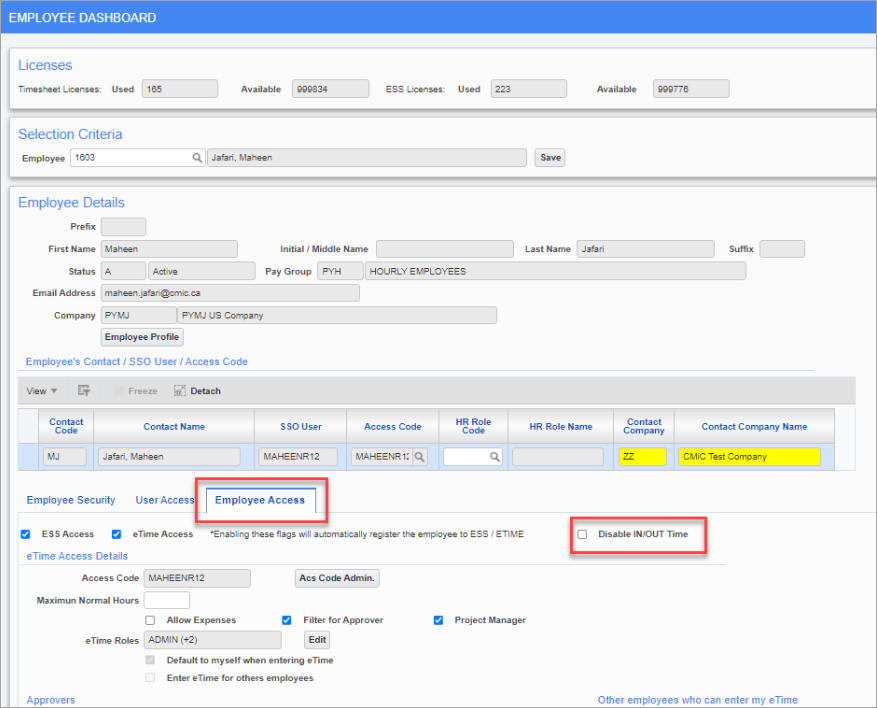
Employee Dashboard; standard Treeview path: Human Resources > Personnel > Employee Dashboard
The Employee Dashboard, located in the Human Resources module, is used to configure access restrictions for an employee's time entries at the HR level. The setting on this screen takes precedence over the system and profile levels.
To configure access for a specific employee at the HR level, navigate to the Employee Dashboard screen and open the Employee record. In the Employee Details section of the screen, click on the Employee Access tab and use the 'Disable IN/OUT Time' checkbox to enable/disable access to the In/Out Time Entry feature when entering timesheets.
Hour Types

Pgm: PYHRTYPE – Hour Types; standard Treeview path: US Payroll > Setup > Company > Hour Types
The Validate In/Out Time field is used to select which hour types will be available when entering in-out times in the Timesheet Entry screen. Hour types with this box checked will be available to be used with this feature, however any hour types left unchecked will not. For example, when selecting an hour type in the Hour Type field while entering a timesheet, the screen will only replace the hours input field with Time In and Time Out fields if the selected hour type has the 'Validate In/Out Time' checked in the Hour Types screen.
Entering In/Out Time
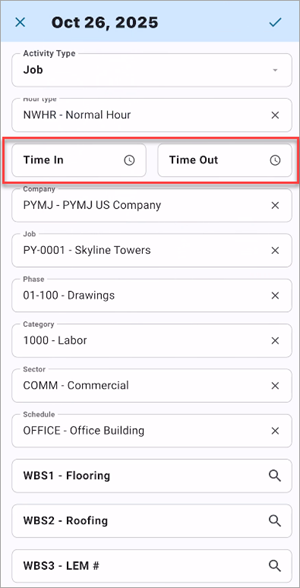
Click on the Add icon (![]() ) to insert a timesheet entry. Select an activity and hour type. Upon selecting "Normal", "Overtime", or "Double time" in the Hour Type field, the interface will dynamically alter, replacing the standard hours input field with distinct fields for Time In and Time Out.
) to insert a timesheet entry. Select an activity and hour type. Upon selecting "Normal", "Overtime", or "Double time" in the Hour Type field, the interface will dynamically alter, replacing the standard hours input field with distinct fields for Time In and Time Out.
NOTE: When selecting an hour type in the Hour Type field, the screen will only replace the hours input field with Time In and Time Out fields if the selected hour type has been set to enforce validation for clocking in and out in the Hour Types screen. Refer to Hour Types for more information.
Manually input the time into the Time In field or use the Clock icon (![]() ) to use the clock interface. By default, the Time In field is pre-populated with the current time. Next, enter the time in the Time Out field. Next, proceed by entering the company, job, phase, and category information as required.
) to use the clock interface. By default, the Time In field is pre-populated with the current time. Next, enter the time in the Time Out field. Next, proceed by entering the company, job, phase, and category information as required.
NOTE: The entered data remains unsaved until a time is specified in the Time Out field. Should an employee decide to make any changes before saving (e.g., to switch the activity type from "J" type to "G" type), any entered data will be cleared, necessitating a fresh input.
When finished, press the Save icon (![]() ).
).
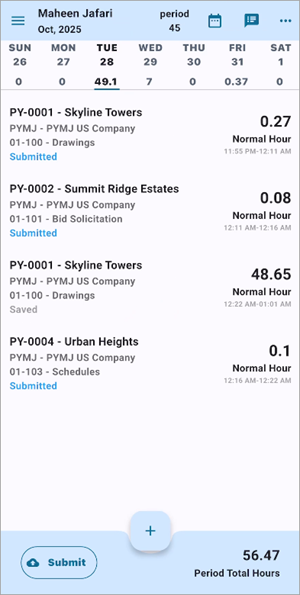
The system computes the total work hours for an employee by considering their Time In and Time Out records. After inputting the data, upon saving, the employee will be directed to the Timesheet Entry screen. Here, they can access a comprehensive overview of their Time In and Time Out details.
NOTE: An employee will be prevented from starting another activity until the current activity is completed.
Copying and Editing Timesheet Entries
The Copy Timesheet feature replicates information, encompassing both time-in and time-out details. Moreover, entries possess the ability to be independently adjusted while in a pending status.
Auto Create Timesheets for Future Approved Leave Requests

Pop-up window launched from [Job Queues] button on System Options screen; standard Treeview path: System > Setup > System Options – General tab
To populate the Timesheet Entry screen with approved leave entries, the 'Auto creating timesheets for future approved leave requests' box must be checked on the [Job Queues] button’s pop-up on the General tab of the System Options screen in the System Data module. Once the period is open, the job queue will run based on the frequency assigned and trigger the approved leave to be displayed in the timesheet.
For more information, please refer to System Data - System Options - General - Tab.